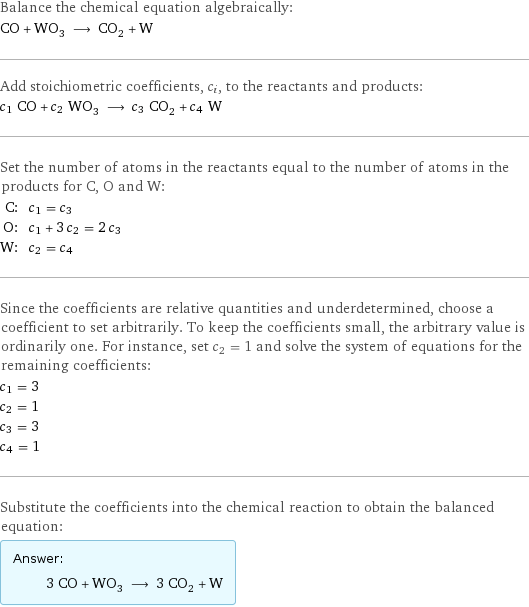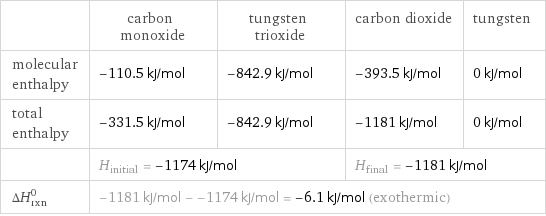Input interpretation

CO carbon monoxide + WO_3 tungsten trioxide ⟶ CO_2 carbon dioxide + W tungsten
Balanced equation

Balance the chemical equation algebraically: CO + WO_3 ⟶ CO_2 + W Add stoichiometric coefficients, c_i, to the reactants and products: c_1 CO + c_2 WO_3 ⟶ c_3 CO_2 + c_4 W Set the number of atoms in the reactants equal to the number of atoms in the products for C, O and W: C: | c_1 = c_3 O: | c_1 + 3 c_2 = 2 c_3 W: | c_2 = c_4 Since the coefficients are relative quantities and underdetermined, choose a coefficient to set arbitrarily. To keep the coefficients small, the arbitrary value is ordinarily one. For instance, set c_2 = 1 and solve the system of equations for the remaining coefficients: c_1 = 3 c_2 = 1 c_3 = 3 c_4 = 1 Substitute the coefficients into the chemical reaction to obtain the balanced equation: Answer: | | 3 CO + WO_3 ⟶ 3 CO_2 + W
Structures

+ ⟶ +
Names

carbon monoxide + tungsten trioxide ⟶ carbon dioxide + tungsten
Reaction thermodynamics
Enthalpy

| carbon monoxide | tungsten trioxide | carbon dioxide | tungsten molecular enthalpy | -110.5 kJ/mol | -842.9 kJ/mol | -393.5 kJ/mol | 0 kJ/mol total enthalpy | -331.5 kJ/mol | -842.9 kJ/mol | -1181 kJ/mol | 0 kJ/mol | H_initial = -1174 kJ/mol | | H_final = -1181 kJ/mol | ΔH_rxn^0 | -1181 kJ/mol - -1174 kJ/mol = -6.1 kJ/mol (exothermic) | | |
Equilibrium constant
![Construct the equilibrium constant, K, expression for: CO + WO_3 ⟶ CO_2 + W Plan: • Balance the chemical equation. • Determine the stoichiometric numbers. • Assemble the activity expression for each chemical species. • Use the activity expressions to build the equilibrium constant expression. Write the balanced chemical equation: 3 CO + WO_3 ⟶ 3 CO_2 + W Assign stoichiometric numbers, ν_i, using the stoichiometric coefficients, c_i, from the balanced chemical equation in the following manner: ν_i = -c_i for reactants and ν_i = c_i for products: chemical species | c_i | ν_i CO | 3 | -3 WO_3 | 1 | -1 CO_2 | 3 | 3 W | 1 | 1 Assemble the activity expressions accounting for the state of matter and ν_i: chemical species | c_i | ν_i | activity expression CO | 3 | -3 | ([CO])^(-3) WO_3 | 1 | -1 | ([WO3])^(-1) CO_2 | 3 | 3 | ([CO2])^3 W | 1 | 1 | [W] The equilibrium constant symbol in the concentration basis is: K_c Mulitply the activity expressions to arrive at the K_c expression: Answer: | | K_c = ([CO])^(-3) ([WO3])^(-1) ([CO2])^3 [W] = (([CO2])^3 [W])/(([CO])^3 [WO3])](../image_source/f5a41ca24d29acf872cc6d57e46c9b97.png)
Construct the equilibrium constant, K, expression for: CO + WO_3 ⟶ CO_2 + W Plan: • Balance the chemical equation. • Determine the stoichiometric numbers. • Assemble the activity expression for each chemical species. • Use the activity expressions to build the equilibrium constant expression. Write the balanced chemical equation: 3 CO + WO_3 ⟶ 3 CO_2 + W Assign stoichiometric numbers, ν_i, using the stoichiometric coefficients, c_i, from the balanced chemical equation in the following manner: ν_i = -c_i for reactants and ν_i = c_i for products: chemical species | c_i | ν_i CO | 3 | -3 WO_3 | 1 | -1 CO_2 | 3 | 3 W | 1 | 1 Assemble the activity expressions accounting for the state of matter and ν_i: chemical species | c_i | ν_i | activity expression CO | 3 | -3 | ([CO])^(-3) WO_3 | 1 | -1 | ([WO3])^(-1) CO_2 | 3 | 3 | ([CO2])^3 W | 1 | 1 | [W] The equilibrium constant symbol in the concentration basis is: K_c Mulitply the activity expressions to arrive at the K_c expression: Answer: | | K_c = ([CO])^(-3) ([WO3])^(-1) ([CO2])^3 [W] = (([CO2])^3 [W])/(([CO])^3 [WO3])
Rate of reaction
![Construct the rate of reaction expression for: CO + WO_3 ⟶ CO_2 + W Plan: • Balance the chemical equation. • Determine the stoichiometric numbers. • Assemble the rate term for each chemical species. • Write the rate of reaction expression. Write the balanced chemical equation: 3 CO + WO_3 ⟶ 3 CO_2 + W Assign stoichiometric numbers, ν_i, using the stoichiometric coefficients, c_i, from the balanced chemical equation in the following manner: ν_i = -c_i for reactants and ν_i = c_i for products: chemical species | c_i | ν_i CO | 3 | -3 WO_3 | 1 | -1 CO_2 | 3 | 3 W | 1 | 1 The rate term for each chemical species, B_i, is 1/ν_i(Δ[B_i])/(Δt) where [B_i] is the amount concentration and t is time: chemical species | c_i | ν_i | rate term CO | 3 | -3 | -1/3 (Δ[CO])/(Δt) WO_3 | 1 | -1 | -(Δ[WO3])/(Δt) CO_2 | 3 | 3 | 1/3 (Δ[CO2])/(Δt) W | 1 | 1 | (Δ[W])/(Δt) (for infinitesimal rate of change, replace Δ with d) Set the rate terms equal to each other to arrive at the rate expression: Answer: | | rate = -1/3 (Δ[CO])/(Δt) = -(Δ[WO3])/(Δt) = 1/3 (Δ[CO2])/(Δt) = (Δ[W])/(Δt) (assuming constant volume and no accumulation of intermediates or side products)](../image_source/5572876d9607eb37c1ab8ae7df34ab9e.png)
Construct the rate of reaction expression for: CO + WO_3 ⟶ CO_2 + W Plan: • Balance the chemical equation. • Determine the stoichiometric numbers. • Assemble the rate term for each chemical species. • Write the rate of reaction expression. Write the balanced chemical equation: 3 CO + WO_3 ⟶ 3 CO_2 + W Assign stoichiometric numbers, ν_i, using the stoichiometric coefficients, c_i, from the balanced chemical equation in the following manner: ν_i = -c_i for reactants and ν_i = c_i for products: chemical species | c_i | ν_i CO | 3 | -3 WO_3 | 1 | -1 CO_2 | 3 | 3 W | 1 | 1 The rate term for each chemical species, B_i, is 1/ν_i(Δ[B_i])/(Δt) where [B_i] is the amount concentration and t is time: chemical species | c_i | ν_i | rate term CO | 3 | -3 | -1/3 (Δ[CO])/(Δt) WO_3 | 1 | -1 | -(Δ[WO3])/(Δt) CO_2 | 3 | 3 | 1/3 (Δ[CO2])/(Δt) W | 1 | 1 | (Δ[W])/(Δt) (for infinitesimal rate of change, replace Δ with d) Set the rate terms equal to each other to arrive at the rate expression: Answer: | | rate = -1/3 (Δ[CO])/(Δt) = -(Δ[WO3])/(Δt) = 1/3 (Δ[CO2])/(Δt) = (Δ[W])/(Δt) (assuming constant volume and no accumulation of intermediates or side products)
Chemical names and formulas

| carbon monoxide | tungsten trioxide | carbon dioxide | tungsten formula | CO | WO_3 | CO_2 | W Hill formula | CO | O_3W | CO_2 | W name | carbon monoxide | tungsten trioxide | carbon dioxide | tungsten